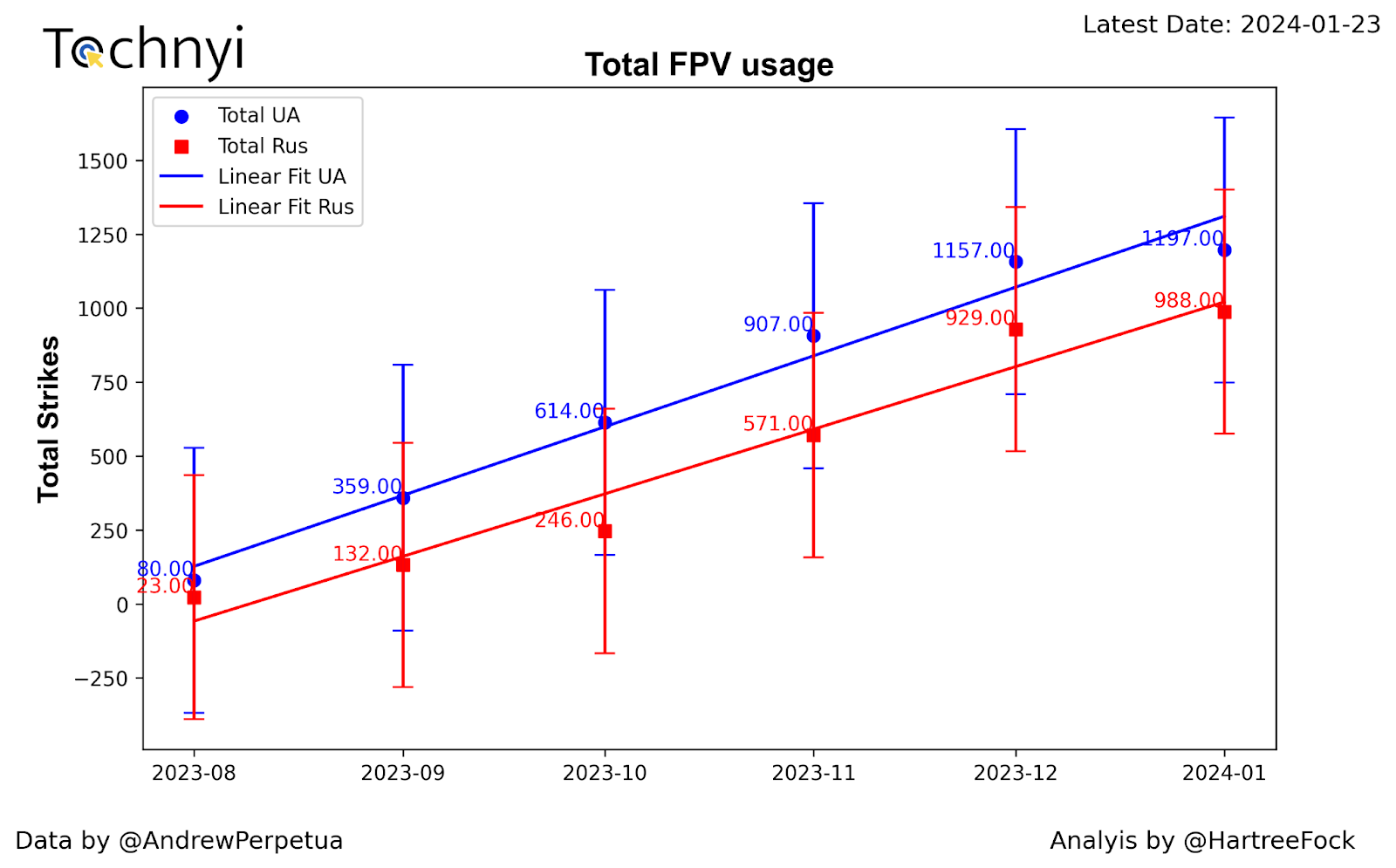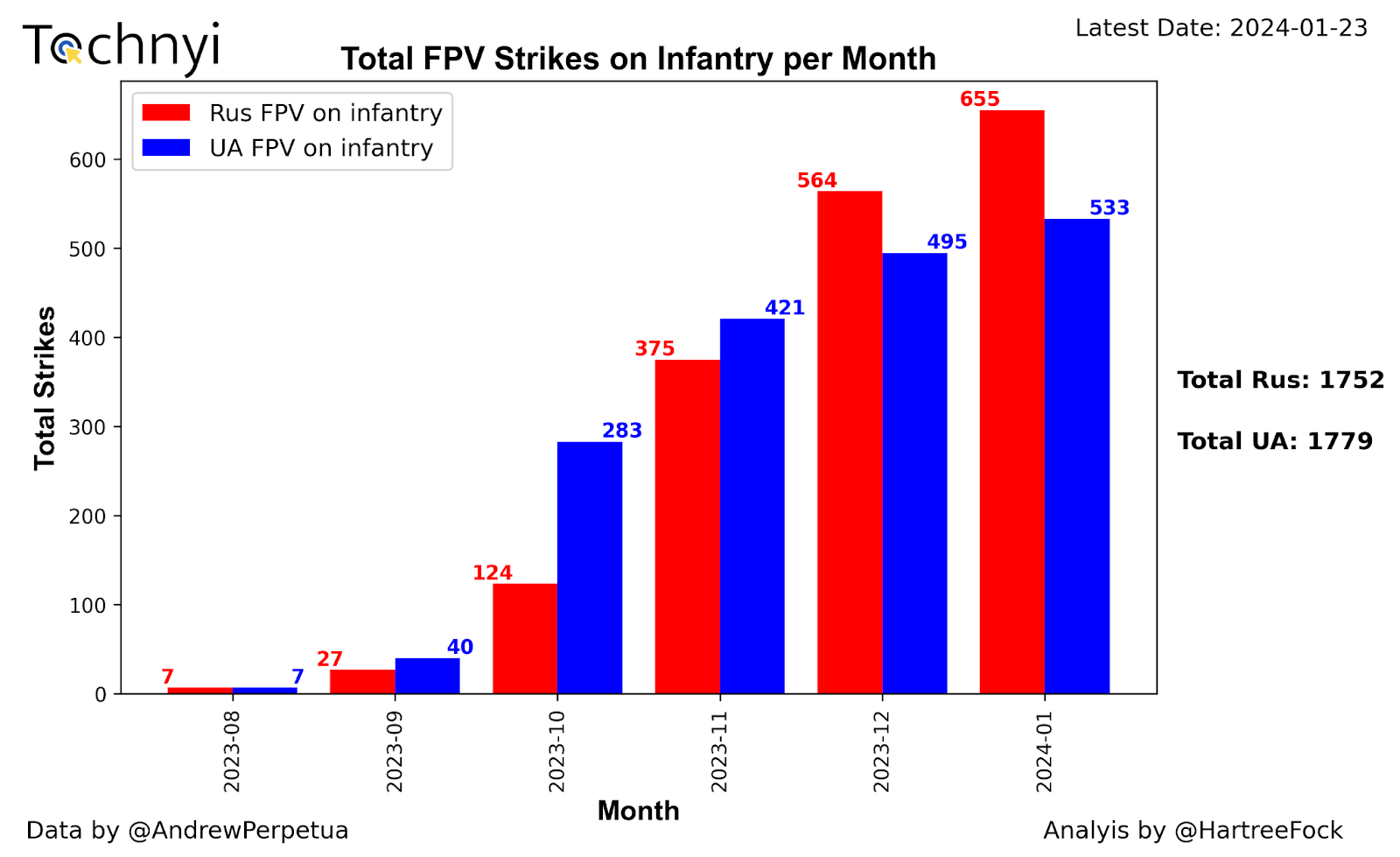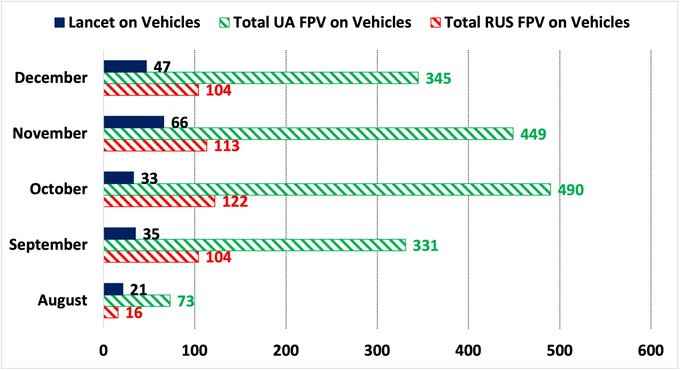On 6 February 2023, Ukraine's President Volodymyr Zelenskyy created a separate branch of forces – the Unmanned Systems Forces — to consolidate previous successful tactics of the battlefield utilization of drones and scale them up. In December 2023, he also announced the goal to manufacture 1,000,000 drones of all types in 2024 in Ukraine — a goal that seems realistic to fulfill by nearly 200 domestic manufacturers.
Inside Ukraine’s campaign to crush Russia with combat drones
At the same time, Russia has been doing the same, utilizing its state-run war machine to introduce the massive use of small drones in the army.
Russian drone manufacturer ‘Orlan-10’ ramps up production despite sanctions, Inform Napalm reports
The Tochnyi OSINT group's report
on FPV drone warfare shows Russia is currently scaling up FPV drone strikes, mirroring Ukraine's approach and having reached nearly 90% of Ukraine's frequency in this type of attack. While the available data taken from the monitoring of open-source videos has likely not recorded every single strike that has taken place, it certainly covers a significant portion of them.
The report used data collected between August 2023 and 23 January 2024 to evaluate the usage of FPV and Lancet drones. Overall, Ukraine maintained some dominance in the number of FPV uses over Russians, although Russians have been developing their drone production at nearly the same pace, with only a few months of lagging.
How many FPV drones do Russia and Ukraine use?
From August 2023 to 23 January 2024, Russia used at least 2,889 FPV drones, while Ukraine used at least 3,886, according to Tochnyi's data. Still, Russia has been steadily increasing its use of FPV drones. The current trend suggests Russia will keep parity with Ukrainian results in the number of FPV strikes. This highlights the necessity for Ukraine to increase its own manufacturing output even more and use more advanced systems to stay ahead in the technological race.
In December and January, the number of Russian FPV drone strikes reached 80% and 82% of the number of Ukrainian strikes, unlike the 2- and 3-times Ukrainian advantage in the previous months.

At the same time, the Russian and Ukrainian tactics of FPV drone strikes are different. Russians mainly target infantry and fortifications, while Ukrainians mainly target vehicles and other military equipment.
The total number of FPV drone attacks on infantry carried out by both sides rapidly increased, but Russians have put even more effort into this type of attack. In October 2023, the Ukrainians conducted considerably more strikes on infantry than the Russians using FPV drones. This situation changed in December following Russia's 2023 production of FPV drones on a large, state-driven scale. The data excludes attacks carried out using reusable drones.

Ukrainian forces maintained a significant superiority in the number of FPV drone strikes against vehicles. The average number of daily FPV strikes against vehicles for Russia was 4, compared with 13 for Ukraine, indicating a strong advantage for Ukraine in this domain.

There was also a small increase in the Russian use of its Lancet drones against vehicles. Still, in light of the number of FPV strikes, Russia's use of Lancet drones remained relatively low, standing at 248 total cases from August to December 2022, with 202 of them against equipment.
Due to the relatively high price of Lancet drones, their use is justified only against valuable targets, such as artillery systems. Videos released by Russians mostly confirm that this tactic is used.

The Russian army also leads in FPV strikes registered against defensive positions such as concrete bunkers, houses, or trenches. Ukrainian videos rarely show this type of strike.
Visual sources have recorded Russia's use of FPV drones as demolition charges to destroy structures, causing the subsequent retreat of the defending force. For example, an FPV drone strike hits a building at one of its weakest points to collapse it and render it unusable as a defensive position. This type of strike has been observed within numerous sources and is not a random occurrence but a systematic Russian tactic. Evidently, Russia's strategy here is to destroy both potential and recognized defensive positions actively.

Vulnerability to drones and drone tactics
Drones have a significant impact on trench lines. Their high precision makes classical lines of trenches considerably less effective. Drones can drop munitions inside the trench, while FPV drones can even fly into dugouts. This raises the question of how trench fortifications can effectively protect against damage from enemy drones.
According to Tochnyi analysts, the frequently used tactic combines artillery barrages with precision strikes using FPV drones. This strategy has been observed frequently, particularly in southern areas with numerous trench systems and tree lines running between settlements. The strategic use of artillery disrupts enemy movement, forcing them to seek shelter in trenches. This sets the stage for accurate FPV strikes targeting infantry in manned positions once an artillery barrage subsides. Russians were more frequently using this tactic, while Ukraine was often forced to use FPVs for precision strikes due to a lack of artillery rounds.
Another tactic used by Ukrainians, particularly in Stepove north of Avidiyivka, consists of surveillance drones actively guiding FPV drones to the target in areas protected by trees or houses, where it is easier for the enemy to hide from a single FPV drone.
Protection of trenches
New tactics to protect positions from drone strikes can include providing overhead cover using metallic nets, surrounding obstacles such as trees, or constructing trenches with higher embankments to obstruct the drone's line of sight and deter drones from entering the trench.
Another vital tactic could be to use less manned trenches and employ an area defense strategy that leverages the strengths of a tightly coordinated defensive operation, allowing forces to consolidate, reorganize, and transition to other tactical operations such as offensive maneuvers. Using quick reaction force methods more often could reduce the need for densely manned trenches. This could be supplemented by introducing unmanned and remotely controlled firing positions.
Several passive approaches aimed at reducing the risk of detection and targeting could also successfully protect against UAVs. This includes camouflage, deception, dispersion, displacement, and protective constructions. The latter are to be considered for shielding the units from detection.
Even factors such as shapes, shadows, patterns, and texture can disrupt a unit's ability to blend with the background and make it vulnerable to FPV drones. One bad example here is the trench lines southwest of Robotyne. Despite these trenches' intricacies, they lack any cover on the trenches themselves. This makes them perfectly visible in recent FPV videos released by Russians operating in this area.
Fortified areas visible to observation and exposed trench lines are one of many cases where a simple surveillance drone can easily assess the force composition within the trench, enabling targeted FPV precision strikes.

Trench concealment methods include keeping the trench well-maintained and deploying netting or other concealment materials wherever possible. One more method is to utilize trench target decoys for deception. Deploying trench decoys could divert the attention of FPV operators and instill uncertainty in the FPV pilot. This would consume the enemy drone stockpile and reduce attacks on real targets.
Read more:
- Study shows drones the cheapest, most effective in battle against Russian invasion
- War of drones: can Ukraine keep its asymmetric advantage?
- Russia plans 68% increase in 2024 military spending, surpassing Ukraine’s defense budget 2.5 times
- Ukraine to launch mass production of jam-resistant drone
- Minister: Ukraine makes tens of thousands of drones per month
- Ukraine deploys 2,000 domestically manufactured drones to most critical fronts of war

